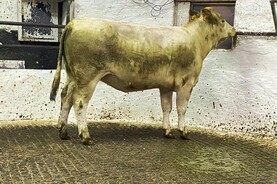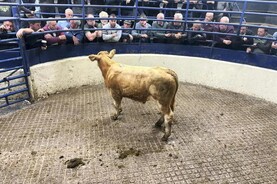Marts are starting to see some bigger numbers moving out this week, with a number of marts across the country moving to two-day sales to cater for the numbers.
Ennis Mart moved to a two-day sale this week and Roscrea Mart had to move to a two-day sale last week with a big entry of store cattle.
Weather, particularly in the west of the country, is taking its toll on ground conditions and some farmers are choosing to offload a little earlier than other years given the deterioration.
Grass supplies also remain tight on some of these farms, so offloading stock is one way of taking some pressure off.
The general consensus is that sales are running two to three weeks ahead of other years in terms of numbers at this stage.
Weanlings continue to be brought out for sale in steady numbers and mart managers say that they don’t expect any glut of weanlings coming in the next six weeks.
September and October are two of the busiest months in terms of weanling sales, but numbers this year won’t see the peaks of previous years.
There are two reasons for this. The good trade and huge export demand meant that weanlings started to move in numbers in July this year.
This means that all autumn-born weanlings are as good as sold at this stage, with early spring-born weanlings now appearing in marts.
The second reason is that there are a lot less suckler-bred calves on the ground.
Suckler registrations are back 40,000 head in 2024, so this is also having an impact on weanling numbers.
Exporters continue to win the ringside battles in marts around the country, with finishers and feedlots continuing to find it very difficult to compete with the export trade.
The Shorthorn Express is due to dock in Greenore Port at the weekend and will be loaded with a consignment of cattle destined for the north African market.
Taking a look at this week’s Martbids analysis table, we see that the bullock trade was the stand-out feature for this week, with all weight ranges and quality types seeing an improvement on last week.
Top-quality bullocks in the 400kg to 500kg weight bracket were up by 10c/kg last week to €3.12/kg.
Heavy bullocks over 600kg were also up by 5c/kg to €3.12/kg.
Poorer-quality dairy-cross bullocks also saw a price rise, with those in the 500kg to 600kg weight bracket coming in at €2.42/kg this week, up 7c/kg on the previous week.
Heifers also had a solid week’s trading with very few changes. Top-quality heifers in the 500kg to 600kg weight bracket came in at €3.08/kg.
Average heifers in the same weight category came in at €2.79/kg, up 3c/kg on the previous week.
In the weanling rings, heavy bulls over 450kg were back a touch on the previous week’s high, but, other than that, weanling sales recorded another positive week.
Top-quality weanlings in the 300kg to 400kg weight bracket came in at €3.85/kg this week.
Lighter calves appear to be in demand again, with farmer buyers driving the trade in this weight category.
Weanling heifers saw a bounce this week, with top-quality heifers in the 300kg to 400kg weight bracket coming in at €3.62/kg, up 16c/kg on the previous week.
Marts are starting to see some bigger numbers moving out this week, with a number of marts across the country moving to two-day sales to cater for the numbers.
Ennis Mart moved to a two-day sale this week and Roscrea Mart had to move to a two-day sale last week with a big entry of store cattle.
Weather, particularly in the west of the country, is taking its toll on ground conditions and some farmers are choosing to offload a little earlier than other years given the deterioration.
Grass supplies also remain tight on some of these farms, so offloading stock is one way of taking some pressure off.
The general consensus is that sales are running two to three weeks ahead of other years in terms of numbers at this stage.
Weanlings continue to be brought out for sale in steady numbers and mart managers say that they don’t expect any glut of weanlings coming in the next six weeks.
September and October are two of the busiest months in terms of weanling sales, but numbers this year won’t see the peaks of previous years.
There are two reasons for this. The good trade and huge export demand meant that weanlings started to move in numbers in July this year.
This means that all autumn-born weanlings are as good as sold at this stage, with early spring-born weanlings now appearing in marts.
The second reason is that there are a lot less suckler-bred calves on the ground.
Suckler registrations are back 40,000 head in 2024, so this is also having an impact on weanling numbers.
Exporters continue to win the ringside battles in marts around the country, with finishers and feedlots continuing to find it very difficult to compete with the export trade.
The Shorthorn Express is due to dock in Greenore Port at the weekend and will be loaded with a consignment of cattle destined for the north African market.
Taking a look at this week’s Martbids analysis table, we see that the bullock trade was the stand-out feature for this week, with all weight ranges and quality types seeing an improvement on last week.
Top-quality bullocks in the 400kg to 500kg weight bracket were up by 10c/kg last week to €3.12/kg.
Heavy bullocks over 600kg were also up by 5c/kg to €3.12/kg.
Poorer-quality dairy-cross bullocks also saw a price rise, with those in the 500kg to 600kg weight bracket coming in at €2.42/kg this week, up 7c/kg on the previous week.
Heifers also had a solid week’s trading with very few changes. Top-quality heifers in the 500kg to 600kg weight bracket came in at €3.08/kg.
Average heifers in the same weight category came in at €2.79/kg, up 3c/kg on the previous week.
In the weanling rings, heavy bulls over 450kg were back a touch on the previous week’s high, but, other than that, weanling sales recorded another positive week.
Top-quality weanlings in the 300kg to 400kg weight bracket came in at €3.85/kg this week.
Lighter calves appear to be in demand again, with farmer buyers driving the trade in this weight category.
Weanling heifers saw a bounce this week, with top-quality heifers in the 300kg to 400kg weight bracket coming in at €3.62/kg, up 16c/kg on the previous week.






 This is a subscriber-only article
This is a subscriber-only article










SHARING OPTIONS: